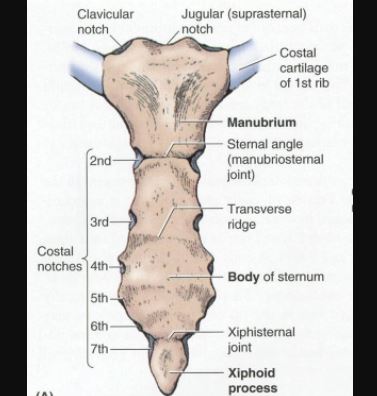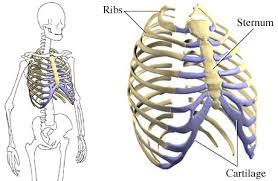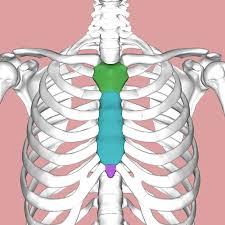What is Sternum Pain?
Sternum pain is a kind of pain, which is associated with the part of the body known as sternum. This body part is also called the breastbone or chest bone and is located in the central position of the chest just below the collar bone. At times, sternum pain can be mistaken for angina or cardiac related pain.

The sternum pain radiates from the chest bone instead of the circulatory system. This kind of pain affecting the sternum can be chronic or acute depending on the cause. People who have this kind of pain say they experience a cracking or clicking sensation at the sternum bone. 1,3,4
Anatomy and Functions
Sternum bone also known as breastbone or chest bone is a flat bone that is found in the middle of thorax or chest. It has two important functions.
- One is that it protects the organs that are found behind it especially the heart and airways.
- Second, it acts as the central point where shoulder bones or clavicle and the ribs connect or articulate.
There are three parts that form sternum bone and they are the manubrium, body, and xiphoid process.

Although sternum bone is also referred to as breast bone, it doesn’t actually lie under the breast, instead, it lies between the breast and extends above and through the cleavage part in women. Sternum pain may range from stabbing and sharp sensations to bruised feeling and mild soreness.
Causes
Sternum pain may be caused by different things ranging from something like a heartburn to psychological and tremor or injury of the bone. Here are some of the common causes of heartburn:
Costochondritis
This is the commonest cause of sternum pain. Costochondritis occurs when the cartilage connecting the ribs to sternum are inflamed.
An individual with costochondritis condition may experience symptoms such as sharp pain or aches occurring on the side of the sternum area.
The person may experience pain or discomforts in one or several ribs. There may also be pain and discomforts that worsen when you breathe in deeply or cough. Costochondritis may be caused by strain from physical actions, chest injury, or a joint condition such as osteoarthritis.
Sternoclavicular joint injury
An injury of the sternoclavicular joint (SC) joint may result in pain within the sternum area. SC joint is the one connecting the top part of sternum to the collarbone or clavicle. If there is an injury to this joint, it could lead to pain in sternum area and the parts of the upper chest where that joint exists.
A person with SC joint injury may have symptoms such as feeling of mild pain or swelling and aching around the upper part of the chest as well as the collarbone area. The individual may also hear clicks and pops coming from the joint area. There may be feeling of stiffness around the joint and the person may not be able to move their shoulder fully.
Collarbone trauma
The collarbone connects directly to the sternum meaning that if is injured, fractured, dislocated, or suffers other forms of trauma, it is likely to cause pain in the sternum area.
Collarbone trauma may present with symptoms such as bumps or bruises around the collarbone injury and swelling or tenderness occurring around the collarbone area.
There may be intense pain if you attempt moving the arms upwards. A person may also hear grinding, pops, or clicks when they lift their arm. They may also experience abnormal frontward sagging of their shoulder.
Sternum fracture
The sternum itself may suffer a fracture and this can cause a lot of pain. The reason why there may be much pain when you have a fractured sternum is because this part of the chest is involved in movements of the upper body. A blunt force applied to the chest may result in fracturing of the sternum bone.
For example, if you are involved in a car accident, the seat belt tightening could induce a force that causes the sternum to fracture.
The chest may be hit when playing sports or indulging in high-impact activities resulting in the fracture of sternum. Symptoms of fractured sternum include pain when you cough or breathe in, difficult breathing, swelling and tenderness occurring over the sternum and clicks, pops, and grinding noises if you move the arms.
Muscle strain or hernia
If you pull or strain a muscle in the chest, it could make the sternum to be painful. A pulled or strained muscle in the chest will present with symptoms like pain around the muscle, tenderness and bruising around the muscle, and discomfort when you use the strained muscle.
Hernia occurs when an organ is pulled or pushed from the locations where it sits normally to an area near that location. For example, hiatal hernia happens when the stomach is pulled up and moves past the diaphragm to sit in the chest cavity.
Hiatal hernia may manifest with symptoms such as feeling like you have taken too much, difficulty swallowing, heartburn, frequent burping, having black-colored stool, and throwing up blood.
Respiratory conditions
When you suffer from respiratory conditions like pleurisy and bronchitis, they may cause pain in sternum. Pleurisy is when the pleura is inflamed. Pleura consists of the tissue in the chest cavity and areas around the lungs.
A person with pleurisy will experience symptoms such as a sharp pain when they sneeze, breathe in, or cough. They will feel as though they cannot get sufficient air. The condition will cause fever and abnormal cough. Bronchitis occurs when the bronchial tubes are inflamed. The inflammation may occur when you have flu or cold.
Other Causes
Other causes of sternum pain include:
- Pneumonia
- Stomach ulcer
- Panic attack
- Heart attack
- Acid reflux
- Surgery of the sternum

Treatment
Treatment of sternum pain is based on the underlying cause.
- If the pain is being caused by digestive issues, a patient may be prescribed medication to relieve the discomfort. Example of those medications are such as those used to treat heartburn and acid reflux.
- Inflammation and costochondritis causing sternum pain may be treated using anti-inflammatory drugs to reduce the swelling occurring in the chest, which may be exerting pressure on the sternum. You can also put ice on the chest to reduce the pain as a temporary measure. People with costochondritis can use warm compresses to relax the tissue.
- If you are experiencing sternum pain accompanied by fever, fainting, breathing problems, abdominal and chest or back pain, vomiting up blood, and reduced palpitations, it may be a case of sternum fracture. A doctor may have to perform X-ray, CT scan, or MRI to confirm if it is a fracture and where it is occurring.
Reference List
- Top 8 Common Causes Of Sternum Pain – http://naturalremedyideas.com/causes-of-sternum-pain/
- Causes of Breast Bone Pain (Sternum) – http://www.healthhype.com/causes-of-breast-bone-pain-sternum.html
- What’s Causing My Sternum Pain? Available at http://www.healthline.com/health/sternum-pain
- Sternum Pain – http://www.md-health.com/Sternum-Pain.html

I have slight soreness and a small lump or raised place on the upper left side of my sternum. I’m more aware of it when I’m lying flat on my back. I’m 76. Is it a cause for concern?